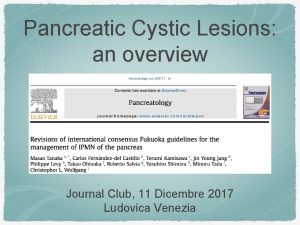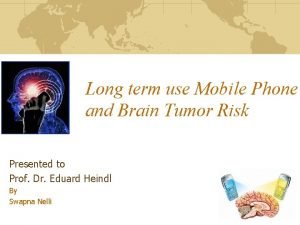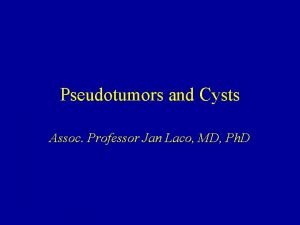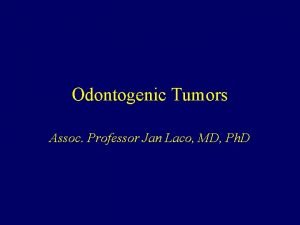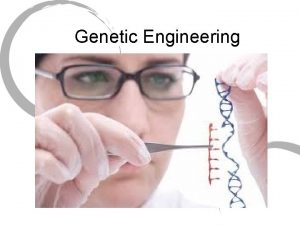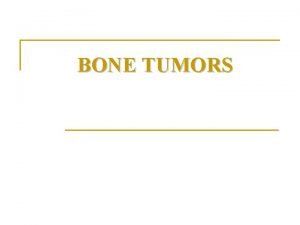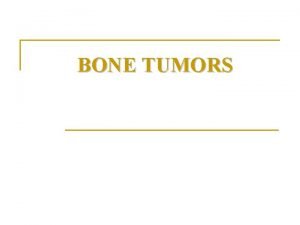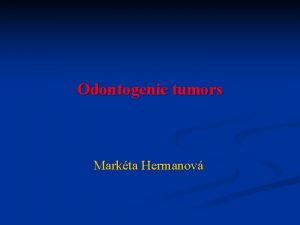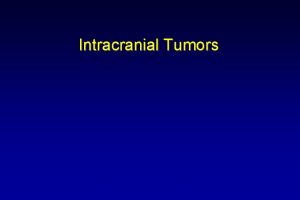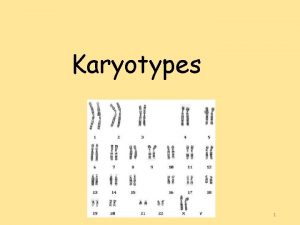Karyotype changes of Tumors The genetic damage that










- Slides: 10

Karyotype changes of Tumors The genetic damage that activate Oncogenes & inactivate Tumor Suppressor Oncogenes is either point mutation (not change the karyotype), or large mutation (change the karyotype). The common structural abnormalities in the genome of tumor cells are: 1. Balanced translocation: (commonest abnormality) More common in hemopoietic tumors e. g. chronic myeloid leukemia (t 9, 22). 2. Deletion: More common in non hemopoietic solid tumor e. g. deletion in chromosome 13 in retinoblastoma, deletion in chromosome 5 in carcinoma of colon. 3. Gene amplification: e. g. breast carcinoma associated with Amplification of Myc & HER 2 genes.

Carcinogenesis according to carcinogens: Carcinogenes can be divided into three steps A. initiation step: in which there is DNA damage (lies at the heart of tumor), usually due to (CHEMICALS, VIRUSES, & RADIATION), these are called initiators. B. promotion step: maintained the damage of DNA (HORMONES, DRUGS, PHENOL), these are called promoters which augment replication of cells with DNA damage. C. Tumor progression: local increase in the size of tumor, local invasion, & metastasis

Important notes on these steps of carcinogenesis: 1. Application of promoters before the initiators will not result in completion of carcinogenesis. 2. Some of carcinogens can act as initiators, promoters, this is called complete carcinogens. 3. Not all carcinogens induced DNA damage will not necessary result in initiation of cancer. 4. Initiators are mutagenic but are not induce cells proliferation, while promoters are nonmutagenic but can induce cells proliferation.

Chemical carcinogenesis: General principles of chemical carcinogens; I. Could be natural or synthetic chemical. II. Chemicals either direct acting chemical (active without transformation in the body), or indirect acting chemical (procarcinogens need transformation inside the body by liver enzymes) to become active (ultimate carcinogens). III. All direct chemicals are highly reactive electrophiles (Free radicals) that react with electron rich atoms in the cells like RNA, DNA. IV. Several chemicals can act in association with other carcinogens like viruses to induce Neoplasia

Mechanism of Chemical carcinogenesis: �Most of chemical carcinogens are mutagenic (initiators). �The commonest protooncogenes that affect by chemical is Ras(mutational activation), while the commonest Tumor suppressor gene affected by chemicals is TP 53 (there is inhibition of TP 53). �Some of chemicals carcinogenesis is augmented by promoters (dugs, hormones, phenol) nonmutagenic but increase proliferation. �Repeated & sustained exposure to promoters must follow the exposure to chemical mutagenic agent or initiator. �Chemicals can induce cancer more in patient with hereditary defect like in Xeroderma Pigmentoza (such patient has DNA damage)

Radiation Carcinogenesis: � �Radiation is a well established carcinogen (like UVlight, nuclear fission, radionuclides). �Examples of cancers induce by radiation are (skin cancer, leukemia, Thyroid cancer, pulmonary caner). �Even therapeutic irradiation can induce cancer (irradiation of neck during infancy & childhood induce papillary carcinoma of thyroid). �Mechanism of carcinogenesis by radiation: �Radiation is mutagenic carcinogens (initiator); it causes chromosome breakage (commonest), translocation, & less commonly point mutation. � �There is a long latent period associated with radiation induced cancer, & this cancer occurs in initially damaged cells by other environmental factor.

Viral & Microbial carcinogenesis: Oncogenic viruses are of two types 1. RNA ONCOGENIC VIRUSES (RETROVIRUS): These viruses cause cancer in animals & human by two mechanisms I. acute transformation virus, contain Oncogenes that cause cancer formation. II. Slow transformation virus, not contain Oncogenes, & induce carcinogenesis by mutation. Example on RNA virus is Human T- cell leukemia type- 1 virus (HTCL-Type – 1) It cause T- cell Leukemia / Lymphoma (endemic in japan). � viruses induce proliferation of CD 4 T- lymphocytes. �Human acquired this infection by transmission of infected T - cells by sexual intercourse, blood products, breast feeding. �Only 1% of infected patient will develop leukemia after long latent period 2 -3 years.

�These viruses contain area that is called PX that is responsible for malignant transformation capacity of viruses, which cause increase transcription of oncogenes of hosts & inhibit P 53. 2. DNA oncogenic viruses: Include 4 viruses: I. Human papilloma virus (HPV). II. Epstein Barr virus (EBV). III. Hepatitis B virus (HBV). IV. Human Herpes virus – 8 (HHV-8).

Human Papilloma virus (HPV) Cause many types of tumors: 1. Benign squamous papilloma of skin (Wart) (by virus type 1, 2, 4, 7). 2. Invasive malignant tumors (carcinoma of cervix, carcinoma of larynx by virus 16, 18, 31). 3. Low malignant potential tumors, (by viruses 6, 11). HPV can cause cancer by production of viral genes E 6, E 7, which result in followings: 1. Stimulate oncogenes & (TP 53). 2. Inhibit Apoptosis. EBV Cause the following diseases: 1. Burkitt lymphoma. 2. CNS tumors, 3. AIDS related lymphoma. 4. Nasopharyngeal carcinoma, 5. Hodgkin lymphoma.

Thank you
 Genetic drift
Genetic drift How is genetic drift different from gene flow
How is genetic drift different from gene flow What is the difference between genetic drift and gene flow
What is the difference between genetic drift and gene flow Genetic programming vs genetic algorithm
Genetic programming vs genetic algorithm Genetic programming vs genetic algorithm
Genetic programming vs genetic algorithm Ipmn
Ipmn Thơ thất ngôn tứ tuyệt đường luật
Thơ thất ngôn tứ tuyệt đường luật Brain tumors
Brain tumors Ectocervix
Ectocervix Odontogenic tumors classification
Odontogenic tumors classification Ameloblastoma rtg
Ameloblastoma rtg





